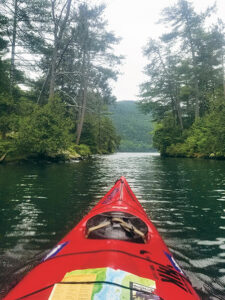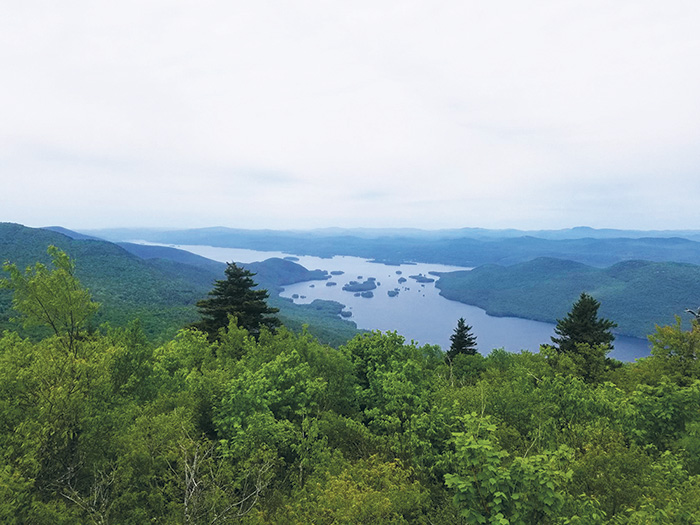By Bob Weinman, Special to The Chronicle

When I was nine years old my dad told me to jump off a cliff.
He also told me to “Take a hike,” “Get out,” and “Go away.”
All great advice, and I love him for that.
Dad and Mom were always taking our family on outdoor adventures. “Taking hikes” in the White, Green and Adirondack mountains; “Getting out” on local lakes, rivers and ski slopes; “Going away” on ski and camping trips; and finally, “Jumping off cliffs,” like the cliff dives on Lake George by Dollar Group, Camp Adirondack and Calves Pen.
It’s May 31st, 2021, my second day paddling the length of Lake George round-trip to Ticonderoga and back.
Strangely, I find myself hiking, not paddling. Last night I napped in the rain on Dollar Group. Today the rain has cleared and just a mile into my paddle I arrive at Five Mile Point at the base of the Tongue Mountain range and decide to land.
“Take a Hike” I can hear my father say, so I do. I follow a steep, switch-backed carriage path past a small pond, an orange newt, a ruffed grouse, a cluster of rare Lady Slipper Orchids, and an equally rare and colorful energy bar wrapper. I leave the Orchids, but I pick up the wrapper.
A mile later I arrive at a modest summit with a tree-veiled view, then trot back down to my kayak. As I slide back into the water I see Black Mountain Point just south of me on the opposite shore and think to myself, “Take a Hike, over there…tomorrow,”
My brother and I were blessed to grow up spending summers on Lake George. There was so much to do and our parents were so willing to show us. The diversity of activities and adventures formed our perception of ourselves and the world around us.

Inspired by this experience my brother and I moved out to the Pacific Northwest after college to explore more adventures, followed by a few side trips to South America and Europe. We spent little time in the cities. Too crowded. Too expensive. Instead, we headed to the mountains, the lakes and the beaches. We camped, climbed, surfed, skied and met great friends on every adventure.
A lone loon calls out as I paddle by Rattlesnake Point. Drifting close to shore I hope to see the elusive timber rattler, for which Lake George is famous but I find no snakes.
I do, however, run into a beach full of basking beauties, spending their Memorial Day weekend soaking up the sparse rays of sun. I wave and one of the girls looks my way. She is the petite one among her peers, and although she seems interested, I can tell she has a thick shell. Her friends, unimpressed, turn away and slip into the water. She hesitates, keeping an eye on me, then joins them.
Map turtles are a modest bunch who spend much of their time underwater, including the entire winter under ice. They are one of seven species of turtles in the Lake George basin, and I feel lucky to have the opportunity to meet these tanning turtles.
11:00 a.m., and I have miles to go.
I dip my empty water bottle into the lake and fill it. The water tastes sweet and I guzzle it down. Will there be a day once again when we can drink unfiltered from all our lakes? I look ahead and paddle a steady pace, pausing only to snap photos of cormorants, loons and seagulls. I arrive at Mossy Point at 4 p.m. and after a quick stretch and PBJ, I am back on the water sprinting home.
I pass Adirondack Camp on the east shore just south of Blair Bay and can’t resist a stop. In the book Images of America — Lake George, authors Gale Halm and Mary Sharp share photos and stories of this iconic summer camp founded in 1904 and still going today.
In the early 19th century, an education movement began using organized summer camps as a means of preparing a stronger and more self-sufficient youth to be future leaders of our growing nation.
It was determined that mosquitos, tippy canoes, muddy hikes, and campfires in remote isolation provided the magic ingredients for this goal.
The Adirondacks, having all the above in abundance, became an epicenter for this new venture. Between 1900 and 1929 at least 100 camps were born in the Lake George and Adirondack region.
Among those still remaining today are YMCA Camp Chingachgook, established on the east shore of Lake George in 1914, and Silver Bay YMCA, established on the west shore in 1902, which later helped launch the Boy Scouts of America during an experimental camp in 1910.
I am lucky to have a family which both embraces and has easy access to outdoor adventure. Just as the children attending these camps have a similar experience and connection with the natural environment.
What is often on my mind, however, is what of the children that may never experience this opportunity to connect with the outdoors on such a personal level. Nature has a way of reminding us that the environment and values mankind has created are at times in direct opposition to the cycles, whims and resilience of the natural world. Outdoor adventure of the smallest type serves to reminds us that we are “a part of” — not “apart from” — the natural world.
Initially most camps were focused on young boys of privilege coming from the cities, but fortunately today a shared goal among these camps is to reach a wider spectrum of campers and families.
In the words of the American Camp Association, they seek to “empower positive change in the world when youth and adults of all backgrounds, beliefs, identities, and abilities are valued and actively engaged in camp and camp leadership”
The sun is setting as I paddle past Huletts landing and after a hike and 27 miles of paddling, I land on Vicars Island and decide to crash for a few hours.
Rising early, I paddle through the needle between Hecker and Hewitt Islands and arrive at Black Mountain Point just before 8 a.m.
With my faithful “band” of humming mosquitos and deerflies, I hike to the summit for a staggering view. It has been such a different experience to add this elevated view of my voyage up and down Lake George.
Horizontally I paddle through micro-environments including a diverse mix of wetlands, creek pools and rocky shores.
Vertically I hike through glades of birch and fern; tangled blowdowns of berries, grasses and stinging nettle; and alpine summits of lichen, juniper and huckleberry.
One thing that I have observed consistently in my shared outdoor adventures is that diversity is a signal of health in nature. I reflect on the news stories of my time, and I just wonder if man’s design will someday finally reach the same conclusion.
Copyright © 2022 Lone Oak Publishing Co., Inc. All Rights Reserved
 Glens Falls Chronicle Serving the Glens Falls/Lake George region; Warren, Washington and northern Saratoga counties since 1980
Glens Falls Chronicle Serving the Glens Falls/Lake George region; Warren, Washington and northern Saratoga counties since 1980

